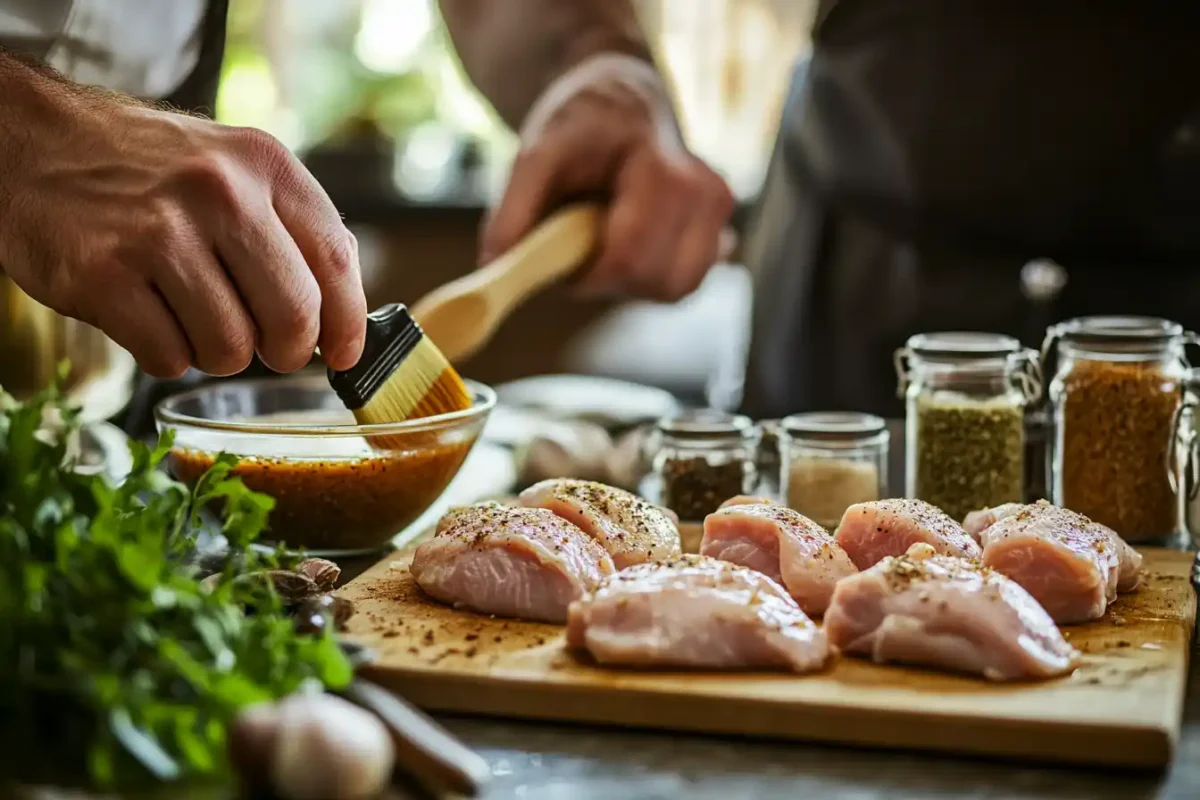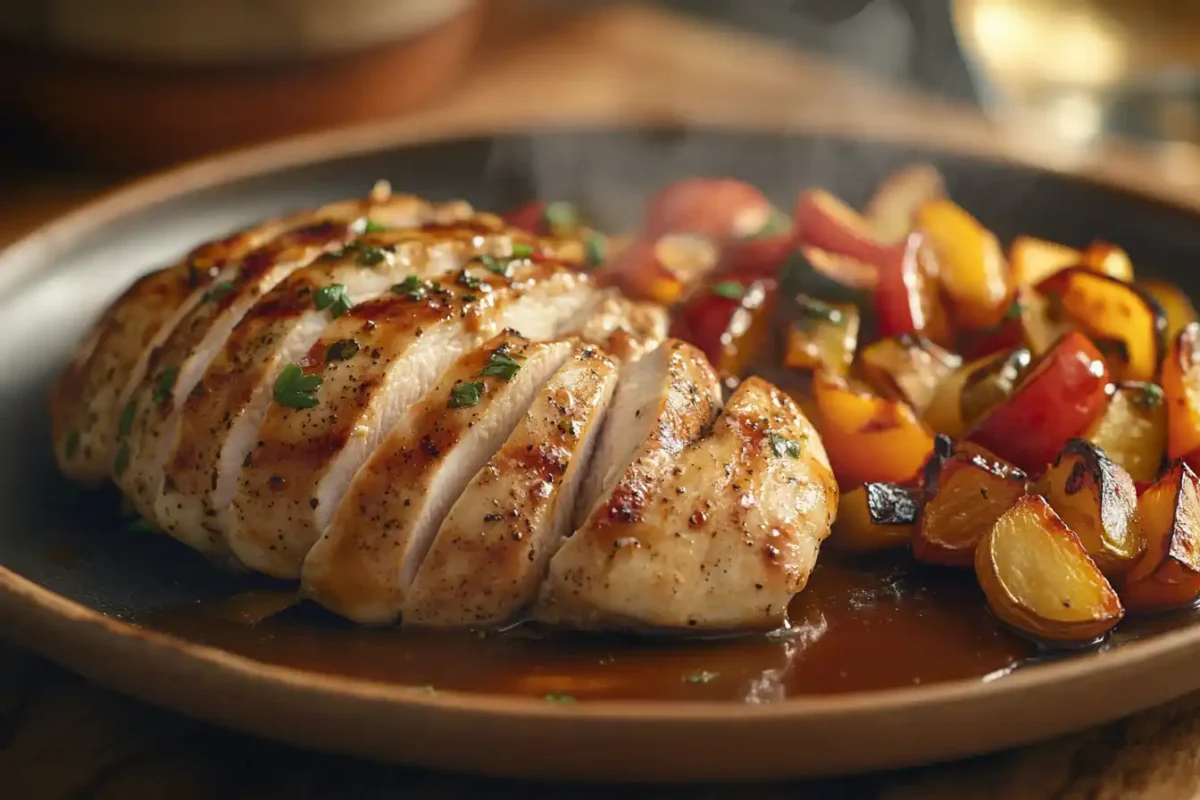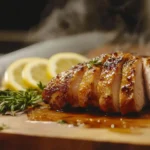We’ve all been there excitedly cutting into a piece of chicken only to find it dry, tough, and completely flavorless. It’s frustrating, especially when you’re trying to keep chicken breast juicy and tender. If you’ve struggled with this, don’t worry you’re not alone.
Thin chicken breasts cook quickly, making them convenient, but they’re also prone to drying out. The secret to juicy, flavorful chicken isn’t just about cooking time it’s about using the right techniques from start to finish. Whether you’re pan-frying, baking, or grilling, this guide will show you exactly how to keep chicken breast juicy every single time.
By the end of this article, you’ll learn the most common mistakes that cause dry chicken and the best cooking methods, including expert tips to keep chicken breast juicy without fail.
Common Mistakes That Cause Dry Chicken Breasts
Before we dive into the best techniques, let’s look at the common mistakes that lead to dry chicken. Avoid these, and you’re already halfway to success.
Overcooking the Chicken
One of the biggest reasons chicken dries out is overcooking. Unlike beef, chicken doesn’t stay juicy when cooked beyond a certain point. The USDA recommends cooking chicken to an internal temperature of 165°F (74°C), but going beyond this can strip the meat of its moisture.
Cooking at Too High a Temperature
High heat might seem like a great way to get crispy chicken, but it can backfire. If the heat is too high, the outside will cook too fast while the inside stays undercooked. By the time the inside reaches a safe temperature, the outside has become dry and tough.
Skipping the Marination or Brining
Seasoning chicken just before cooking helps, but it’s not enough to lock in moisture. Marinating or brining the chicken before cooking can make a huge difference. A simple saltwater brine or a flavorful marinade can help to keep chicken breast juicy by allowing it to absorb extra moisture.
Not Letting the Chicken Rest After Cooking
Cutting into chicken immediately after cooking lets all the juices escape, leaving you with dry meat. Resting the chicken for 5-10 minutes allows the juices to redistribute, making each bite more tender and flavorful.
Best Methods to Keep Thin Chicken Breasts Juicy

Brining: The Best Way to Lock in Moisture
Brining is one of the easiest ways to keep chicken breast juicy. A saltwater brine helps the chicken absorb moisture, keeping it tender even after cooking.
Simple Chicken Brine Recipe
| Ingredient | Quantity |
|---|---|
| Water | 4 cups |
| Salt | ¼ cup |
| Sugar (optional) | 2 tablespoons |
| Garlic (minced) | 2 cloves |
| Lemon juice | 2 tablespoons |
How to Brine Chicken:
- Mix the salt, sugar, garlic, and lemon juice into the water until fully dissolved.
- Submerge the thin chicken breasts in the brine and refrigerate for at least 30 minutes (or up to 4 hours).
- Remove the chicken, pat dry, and cook as desired.
Marinating for Maximum Flavor and Tenderness
Marinating adds both moisture and flavor. The key is to use a marinade with an acidic component (like lemon juice or vinegar) and oil to keep chicken breast juicy.
Easy Chicken Marinade Recipe
| Ingredient | Quantity |
|---|---|
| Olive oil | ¼ cup |
| Lemon juice | 2 tablespoons |
| Garlic (minced) | 2 cloves |
| Honey | 1 tablespoon |
| Salt and black pepper | To taste |
How to Marinate Chicken:
- Combine all ingredients in a bowl or zip-lock bag.
- Add the chicken breasts and coat evenly.
- Refrigerate for at least 30 minutes (or up to 12 hours for deeper flavor).
- Remove the chicken from the marinade and cook as desired.
Pounding Chicken to an Even Thickness
Unevenly thick chicken breasts cook at different rates, which can cause dryness in thinner parts while the thicker parts finish cooking. Pounding the chicken to an even thickness helps it cook evenly and retain moisture.
How to Pound Chicken:
- Place the chicken breast between two sheets of plastic wrap.
- Use a meat mallet or rolling pin to gently pound the thickest part until even.
- Cook as usual for a more consistent texture.
Using a Meat Thermometer for Precision Cooking
The easiest way to avoid overcooking is by using a meat thermometer. When the thickest part of the chicken reaches 165°F (74°C), it’s ready to eat.
Cooking Chicken on Medium Heat for Perfect Texture
Instead of blasting the heat on high, cooking at medium heat ensures the chicken cooks evenly. Medium heat allows the inside to cook through without drying out the exterior.
Resting the Chicken Before Slicing
After cooking, let your chicken rest for at least 5 minutes before cutting. This lets the juices redistribute, keeping the meat moist.
Best Cooking Methods for Juicy Thin Chicken Breasts
Now that you know how to keep chicken breast juicy using brining, marinating, and proper preparation techniques, it’s time to focus on the best cooking methods. The right cooking method ensures that your chicken stays tender and flavorful without drying out.
Pan-Searing: The Quick and Flavorful Method
Pan-searing is one of the easiest ways to keep chicken breast juicy. It creates a delicious golden crust while sealing in moisture.
How to Pan-Sear Thin Chicken Breasts
- Heat a skillet over medium heat and add one tablespoon of olive oil or butter.
- Once the pan is hot, place the seasoned chicken breasts in the pan.
- Cook for 3-4 minutes on each side until golden brown.
- Check for an internal temperature of 165°F (74°C), then remove from heat.
- Let the chicken rest for 5 minutes before slicing.
| Cooking Method | Temperature | Cooking Time |
|---|---|---|
| Pan-Searing | Medium Heat | 3-4 minutes per side |
Baking: Even Cooking Without Drying Out
Baking is an excellent hands-off method that keeps chicken moist, especially when cooked with a light coating of oil or covered with foil.
How to Bake Thin Chicken Breasts
- Preheat the oven to 375°F (190°C).
- Line a baking sheet with parchment paper or lightly grease a baking dish.
- Brush the chicken breasts with olive oil and season as desired.
- Bake for 15-20 minutes, depending on thickness.
- Use a meat thermometer to check that the internal temperature reaches 165°F (74°C).
- Let the chicken rest for 5 minutes before serving.
| Cooking Method | Temperature | Cooking Time |
|---|---|---|
| Baking | 375°F (190°C) | 15-20 minutes |
Air Frying: Crispy Yet Moist Chicken
Air frying is a great way to get crispy chicken with minimal oil while keeping the inside tender.
How to Cook Thin Chicken Breasts in an Air Fryer
- Preheat the air fryer to 375°F (190°C).
- Lightly spray the chicken with oil and season well.
- Place the chicken in a single layer in the air fryer basket.
- Cook for 8-10 minutes, flipping halfway through.
- Ensure the internal temperature reaches 165°F (74°C) before serving.
| Cooking Method | Temperature | Cooking Time |
|---|---|---|
| Air Frying | 375°F (190°C) | 8-10 minutes |
Grilling: Achieving the Perfect Char Without Dryness
Grilling gives chicken a smoky, charred flavor, but thin chicken breasts can dry out quickly if not cooked properly.
How to Grill Thin Chicken Breasts
- Preheat the grill to medium-high heat.
- Brush the chicken with oil to prevent sticking.
- Grill for 3-4 minutes per side, flipping once.
- Check for an internal temperature of 165°F (74°C) before removing from the grill.
- Let rest for 5 minutes before slicing.
| Cooking Method | Temperature | Cooking Time |
|---|---|---|
| Grilling | Medium-High Heat | 3-4 minutes per side |
How to Fix Dry Chicken Breasts
If you’ve accidentally overcooked your chicken and it turns out dry, don’t worry! Here are a few simple ways to bring it back to life.
Adding Sauce or Broth to Rehydrate Dry Chicken
One of the easiest ways to fix dry chicken is to slice it and toss it in a flavorful sauce or broth. This helps restore moisture and adds extra flavor.
Using Chicken in Soups, Stir-Fries, or Salads
If your chicken turned out dry, consider repurposing it in soups, stir-fries, or salads where it can absorb other flavors and moisture.
Shredding and Mixing with Moist Ingredients
Shredding the chicken and mixing it with ingredients like mayonnaise, yogurt, or avocado can turn dry chicken into a delicious filling for sandwiches or wraps.
Expert Tips for Keeping Chicken Juicy Every Time
Now that you know the best cooking methods to keep chicken breast juicy, let’s go over some expert tips that will guarantee tender, flavorful chicken every time.
Choosing the Right Chicken for Best Results
Not all chicken breasts are the same. For the best texture and flavor, go for organic or air-chilled chicken, which tends to retain more moisture compared to water-chilled varieties. If possible, buy fresh rather than frozen, as freezing can sometimes dry out the meat.
The Role of Fat: Butter, Olive Oil, and Cooking Sprays
Fat plays a crucial role in keeping chicken moist. Using olive oil or butter when cooking helps create a protective barrier, sealing in the natural juices. If grilling or air frying, a light spray of oil can prevent the chicken from drying out.
Covering the Chicken While Cooking to Retain Moisture
Covering the chicken with a lid or foil while baking or grilling traps steam, preventing moisture loss. If pan-frying, loosely covering the pan with a lid for the first couple of minutes can help keep the chicken tender.
How to Store and Reheat Chicken Without Drying It Out

Proper storage and reheating methods can make a big difference in maintaining moisture.
Best Way to Store Cooked Chicken
- Let the chicken cool completely before storing.
- Store in an airtight container in the refrigerator for up to 4 days.
- For freezing, wrap tightly in plastic wrap and store in a freezer-safe bag for up to 3 months.
Best Way to Reheat Chicken Without Drying It Out
| Reheating Method | Temperature | Instructions |
|---|---|---|
| Oven | 325°F (163°C) | Wrap chicken in foil with a tablespoon of broth. Heat for 10-15 minutes. |
| Microwave | Medium Power | Place in a microwave-safe dish with a damp paper towel. Heat in 30-second intervals. |
| Stovetop | Medium Heat | Reheat in a pan with a splash of broth, covering for moisture. |
Best Seasonings and Marinades for Thin Chicken Breast
Seasoning is key to enhancing the flavor of chicken. Here are some delicious seasoning blends to try:
| Type | Ingredients |
|---|---|
| Classic | Salt, black pepper, garlic powder, onion powder |
| Italian | Oregano, basil, rosemary, Parmesan cheese |
| Spicy | Cayenne pepper, paprika, chili powder, cumin |
| Asian | Soy sauce, ginger, garlic, sesame oil |
Frequently Asked Questions (FAQs)
Can You Cook Thin Chicken Breast from Frozen Without Drying It Out?
Yes, but it takes longer. Add 5-7 extra minutes to the cooking time and cook at a slightly lower temperature to avoid drying it out. For best results, thaw the chicken in the fridge overnight before cooking.
What Is the Best Temperature to Cook Thin Chicken Breast?
The best cooking temperature depends on the method:
- Pan-frying: Medium heat
- Baking: 375°F (190°C)
- Air frying: 375°F (190°C)
- Grilling: Medium-high heat
How Do You Know When Chicken Is Fully Cooked but Still Juicy?
Using a meat thermometer is the best way. Chicken is safe to eat at 165°F (74°C). If you don’t have a thermometer, cut into the thickest part it should be white throughout with clear juices.
Explore More Delicious Recipes
- Easy Thin Chicken Recipes
- This Is Why Your Thin Sliced Chicken Turns Out Dry
- Delicious Marry Me Chicken with Pasta
Final Thoughts – Enjoy Juicy, Flavorful Chicken Every Time
Now that you’ve mastered how to keep chicken breast juicy, you can confidently cook delicious, tender chicken every time. Whether you bake, pan-fry, grill, or air-fry, using the right techniques makes all the difference.
What’s your favorite way to keep chicken breast juicy? Let us know in the comments, and don’t forget to follow us for more cooking tips and recipes!
Happy cooking with Rita Chef ❤️!
Print
Secrets to Juicy Thin Chicken Breasts
- Total Time: Twenty-five minutes
- Yield: Two servings
Description
Tired of dry and flavorless chicken? Learn how to keep chicken breast juicy with simple cooking techniques, marinades, and expert tips. This guide covers the best methods for pan-searing, baking, air frying, and grilling while ensuring your chicken stays tender and moist every time.
Ingredients
For the Chicken
Two thin sliced chicken breasts
One teaspoon salt
One teaspoon black pepper
One teaspoon garlic powder
One teaspoon paprika
One tablespoon olive oil or butter
For the Marinade (Optional but Recommended)
Two tablespoons olive oil
One tablespoon lemon juice
One teaspoon honey
One teaspoon Dijon mustard
One teaspoon dried oregano
One clove garlic minced
Instructions
Prepare the Chicken
Place the chicken breasts between two sheets of plastic wrap and gently pound them to an even thickness for even cooking
Pat dry with a paper towel to remove excess moisture
Season the Chicken
Rub both sides with salt black pepper garlic powder and paprika
If using the marinade combine all marinade ingredients in a bowl and coat the chicken letting it sit for at least thirty minutes or up to overnight in the refrigerator
Pan-Frying Method
Heat a pan over medium heat and add olive oil or butter
Once hot place the chicken in the pan and cook for three to four minutes on each side until golden brown
Check that the internal temperature reaches 165°F 74°C before removing from heat
Let rest for five minutes before slicing to keep it juicy
Oven-Baked Method
Preheat the oven to 375°F 190°C
Place the seasoned chicken on a baking sheet lined with parchment paper
Bake for fifteen to twenty minutes depending on thickness
Use a meat thermometer to ensure it reaches an internal temperature of 165°F 74°C
Let rest for five minutes before serving
Air Fryer Method
Preheat the air fryer to 375°F 190°C
Place chicken in the basket in a single layer
Cook for eight to ten minutes flipping halfway through
Ensure the internal temperature reaches 165°F 74°C before serving
Grilling Method
Preheat the grill to medium high heat
Brush the chicken with oil to prevent sticking
Grill for three to four minutes per side flipping once
Check for an internal temperature of 165°F 74°C before removing from the grill
Let rest for five minutes before slicing
Notes
For best results always let the chicken rest for five minutes after cooking to retain moisture
If using frozen thin sliced chicken thaw completely before cooking for even results
Use a meat thermometer to avoid overcooking and dryness
- Prep Time: Ten minutes
- Cook Time: Fifteen minutes
- Category: Main Dish
- Method: Pan-Frying Baking Air Frying Grilling
- Cuisine: Universal
Nutrition
- Serving Size: One chicken breast
- Calories: Two hundred twenty kcal
- Sugar: One gram
- Sodium: Five hundred mg
- Fat: Ten grams
- Saturated Fat: Three grams
- Unsaturated Fat: Six grams
- Trans Fat: Zero grams
- Carbohydrates: Two grams
- Fiber: One gram
- Protein: Twenty-five grams
- Cholesterol: Seventy mg

